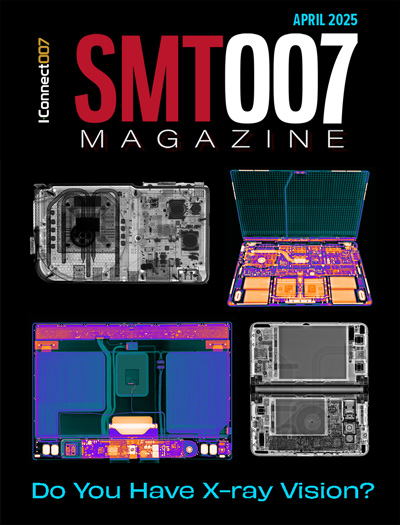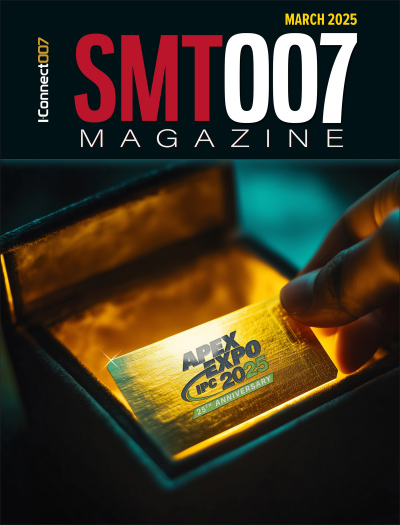-

- News
- Books
Featured Books
- smt007 Magazine
Latest Issues
Current Issue
Do You Have X-ray Vision?
Has X-ray’s time finally come in electronics manufacturing? Join us in this issue of SMT007 Magazine, where we answer this question and others to bring more efficiency to your bottom line.

IPC APEX EXPO 2025: A Preview
It’s that time again. If you’re going to Anaheim for IPC APEX EXPO 2025, we’ll see you there. In the meantime, consider this issue of SMT007 Magazine to be your golden ticket to planning the show.

Technical Resources
Key industry organizations–all with knowledge sharing as a part of their mission–share their technical repositories in this issue of SMT007 Magazine. Where can you find information critical to your work? Odds are, right here.
- Articles
- Columns
Search Console
- Links
- Media kit
||| MENU - smt007 Magazine
In-process Quality Control: The Route to Zero-defect Manufacture
December 31, 1969 |Estimated reading time: 10 minutes
By Thomas Eskridge
The end goal of implementing AOI will determine where it should be placed in the line and what process control information will be generated.
 Figure 1. This production line layout has inspection immediately after screen printing.
Figure 1. This production line layout has inspection immediately after screen printing.
As printed circuit assemblies (PCA) get smaller and denser, automated optical inspection (AOI) equipment increasingly is used to monitor and ensure printed circuit board (PCB) quality. Additionally, effective AOI implementation with specific goals in mind can generate different types and detail levels of process control information.

There are four types of inspection goals for implementing AOI:
- End quality. Manufacturers focusing on end quality principally are interested in the product's status as it comes off the line. This goal is prioritized when production issues are well known, the product mix is high, and the key drivers are quantity and speed. AOI commonly will be placed near the end of the line. In this position, the equipment can generate a wide process control information range.
- Process tracking uses inspection equipment to monitor the production process. Typically, this includes detailed defect classification and component placement offset information. Manufacturers prioritize this goal when product reliability is important and large volumes are manufactured with a low mix and stable part supply. This often involves moving the inspection equipment to several places in-line to monitor performance in detail. Process control information generally is less than when addressing end-quality goals, but it may address specific process problems directly. Process control information that supports particular process steps may be more quantitative than when addressing other goals.
- In-circuit test (ICT) first-pass yields (FPY) reflect process capability and any difficulties with the ICT process. AOI equipment improves yields at ICT by capturing and routing defective boards to be reworked before the first ICT. Manufacturers prioritize this goal when there are large production runs needed on short notice, making the ability to test and ship product the key issue. Because AOI placement is near the end of the production line, process control information typically is qualitative in nature.
- Characterization. In the production of critical-use assemblies, i.e., medical or military applications, inspection equipment must be tuned to find all possible anomalies. This results in a nearly nonexistent escape rate, but it generates false calls and requires a longer inspection time. AOI typically is used at the end of the line to inspect solder joints, but it may be moved to monitor specific processes. The key production drivers for this goal are product type, the risk accepted for field failure and available inspection time. Qualitative and quantitative process control information may be generated depending on the inspection equipment's location and setup.
 Figure 2. AOI located pre-reflow can detect solder paste and placement errors.
Figure 2. AOI located pre-reflow can detect solder paste and placement errors.
For many applications, there will be no difference in AOI machine setup for any of these goals. Differences arise in how the inspection machine is used. For example, the inspection machine typically will only flag severe defects. However, if characterization is the inspection goal, the user may browse (or have the inspection equipment report) anomalies that are less severe to fully characterize the product. Inspection equipment must support each of these inspection goals and fluidly move from one to another.
 Figure 3. This line layout has inspection after reflow.
Figure 3. This line layout has inspection after reflow.
Similarly, process control information may differ depending on equipment usage. For example, although component placement information can be collected and monitored with post-reflow inspection, this information's utility will be different than that collected in a pre-reflow location. Defect correlation to placement machine errors can be more tenuous at this site.
Implementation Strategies
Where a machine is placed can enable or hinder inspection goals, and different locations can produce correspondingly different process control information. AOI placement location is determined by:
- Particular production problems. If there are specific problems in the line, inspection equipment can be added or moved to that location to monitor defects and catch repetitious problems early.
- Implementation goals. There is no one best location for an inspection machine to handle all production line defects (Table 1). If the goal for implementing AOI is to improve overall end quality, placing a machine early in the process may not be of as much value as one placed late in the process. One argument for early machine placement is to prevent the addition of more value to an already defective product. Also, the cost to repair defects early in the process is significantly less than the repair cost before or after shipment. However, many defects appear in the latter stages of production, meaning that no matter how many defects are caught early, there is a need for full visual inspection before shipment.
Placement Location
Although AOI may be placed after any part of the assembly process, there are three primary inspection locations:
After solder paste deposition (Figure 1). If the solder paste deposition process is within specifications, the number of defects found at ICT may be reduced dramatically.1 Faulty deposition can be linked to the following problems:
- Insufficient solder on a pad.
- Excessive solder on a pad.
- Solder misregistered with respect to the pad.
- Solder bridging between pads.
 Figure 4. FPY process charts monitor production line performance. Significant deviations in FPY may indicate a systematic defect.
Figure 4. FPY process charts monitor production line performance. Significant deviations in FPY may indicate a systematic defect.
The probability of a defect at ICT related to these conditions is directly proportional to the condition's severity. Slightly insufficient solder rarely causes a defect, while a severe condition, such as no solder at all, almost always results in a defect at ICT. Insufficient solder could be one reason for a missing component or an open joint. However, the determination of where to place AOI needs to recognize that missing components can occur for other reasons, and these reasons must be accounted for in the inspection plan. Inspection at this location most directly supports the process tracking and characterization goals.The quantitative process control data available at this stage include placement offset and solder volume information, while qualitative information concerning printed solder also is generated.
 Figure 5. A Pareto chart of all defects together with a cumulative indication of defect percentage enables operators and process engineers to zero in on the production steps that may be causing problems.
Figure 5. A Pareto chart of all defects together with a cumulative indication of defect percentage enables operators and process engineers to zero in on the production steps that may be causing problems.
Pre-reflow (Figure 2) inspection is done after components are placed on the board into the solder paste and before the PCB is sent into reflow ovens. This is a typical location to place inspection machines because most defects resulting from solder paste deposition as well as machine placement can be detected. Quantitative process control information generated at this location provides chipshooter and fine-pitch component placement calibration information. This information can be used to modify component placement or indicate that placement machine calibration is needed. Inspection at this location supports all AOI implementation goals.
Post-reflow (Figure 3) inspection is the final step in the SMT process, preceding ICT, functional and systems tests performed before shipment. It is the most popular choice for AOI, as the sum of assembly errors can be found at this location. Post-reflow provides a high degree of security because it detects errors caused by solder paste deposition, placement and the reflow process. Inspection at this location supports all AOI implementation goals.
Although quantitative information can be generated at this point, it can be difficult to correlate errors to a definitive cause. However, the generated qualitative information may provide the most accurate indicator of overall process health, because at this location, the SMT process is complete.
While each position may be ideal for detecting a specific defect, the challenge of AOI implementation is placing the inspection equipment where the most defects can be detected and corrected as easily as possible.
Process Control Information
There are two types of process control information generated by AOI equipment. Quantitative information, such as component offset measurements, can be used to monitor the placement machine status. This follows the logic that placement accuracy is a good indicator of overall production process quality. Qualitative information generated by inspection equipment can determine overall assembly process quality by directly reporting defect information. This information can be used to determine systematic defects in the manufacturing process. The process for analyzing the information works as follows.
 Figure 6. Solder short locations indicated in Figure 5 are shown here.
Figure 6. Solder short locations indicated in Figure 5 are shown here.
One control chart is chosen as the master monitoring chart. This chart constantly is on display at the inspection machine or rework station. Operators scan the chart to determine if the process is out of tolerance. For pre-reflow inspection stations monitoring component placement, the chart typically is a scatter plot of component offsets. When a plotted point goes beyond preset limits, the operator can repair the fault and possibly service or adjust the placement machine. For post-reflow applications, the master monitoring chart will be either a defect Pareto chart or an FPY chart. Figure 4 shows a typical FPY quality control chart. The chart compares FPY figures generated from the AOI equipment and the operator at the PCA rework station over one month. Because FPY is a good indicator of overall process line performance, this chart generally is a key process monitoring tool. At any time, the operator can select a point to investigate further, and a more detailed defect classification chart can be generated.
Figure 5 is a report that summarizes defects by their classification in a Pareto chart. Process control charts like this typically are brought up when the FPY chart shows some anomaly. This chart informs the process engineer what defect types are occurring. In this example, the most significant defect is solder bridging, which accounts for 42 percent of the defects. The line graph shows the cumulative percentage of defects associated with the Pareto chart bars. It indicates that the top three defects account for 75 percent of errors occurring on the product. If these defects can be eliminated, significant process improvement may be obtained. Drilling further into this data, the locations of the solder shorts can be determined.
Figure 6 indicates where the solder short defects occur. By examining the occurrence of specific defects by location, the process engineer can better determine the defects' root cause. In this example, the location with the most defects accounts for 15 percent of the total number of solder bridges. While this is significant, the defect's root cause will require further investigation.
Qualitative quality control charts give the operator and process engineers the tools to refine the search for defects' root causes and highlight systematic defects.
Future of AOI
The AOI industry is striding toward the final goal of zero-defect manufacturing, but it is not there yet. Current state of the art is a set of descriptive statistics that show the process engineer what happened, but it is not yet adept at warning operators what is likely to happen. Similarly, divining the root cause of defects is assisted by the types of control charts produced by AOI systems, but the systems rarely can determine root causes by themselves. The component-placement/component-offset inspection loop just is beginning to close to the point that an inspection machine pre-reflow can send offset correction signals directly to the placement machine, modifying its placement program.
The future of AOI, regarding process quality control, will involve intelligent software systems that interpret statistics, correlate information with quality data and variables from other production equipment to predict defects before they happen, and determine probable root causes of process errors on the fly. Further system capability increases will enable automatic corrective actions.
Conclusion
Four key inspection goals cut across all types of manufacturers. Where to place AOI in the line is dependent on what the end goal is. Location also impacts the quality of the process control metrics generated by the inspection equipment. This must be taken into considered to make sure the AOI implementation goal is being met.
Inspection goals change as the process changes and matures. AOI equipment must be flexible to adapt to change. It is important that the equipment is easy to move to different locations on the production line, and accurately can detect and classify defects. Different process statistics will be necessary at different times, as well. Recognizing when the descriptive statistics generated by AOI are appropriate for addressing process changes is the next stop on the route to zero-defect manufacturing.
REFERENCES
- D. Burr, "Printing Guidelines for BGA and CSP Assemblies," Proceedings of SMI '98, p. 417-24.
- W. Sauer, H. Wohlrabe and T. Zerna, "Process Capability Coefficient and Placing Accuracy as Benchmarking Values of SMT Placement Systems," Proceedings of SMI '98, p. 489-99.
- N. Lee, "Optimizing Reflow Profile Via Defect Mechanisms Analysis," Proceedings of SMI O98, p. 435-44.
THOMAS ESKRIDGE may be contacted at Intelligent Reasoning Systems Inc., 100 Michaelangelo Way, Building E900, Austin, TX 78728.


